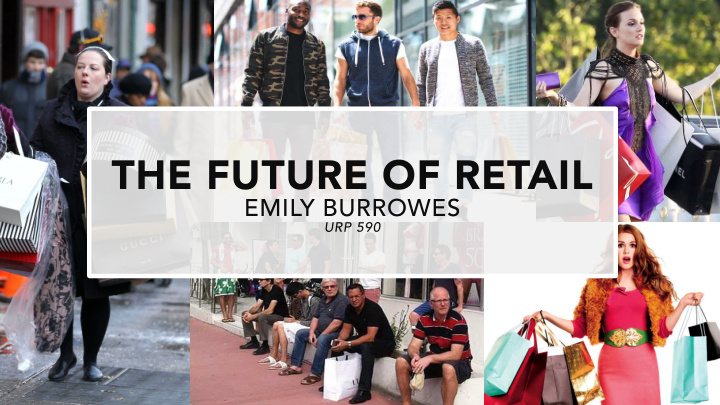



THE FUTURE OF RETAIL EMILY BURROWES URP 590
HISTORY OF RETAIL 9000 BC Trade of animals Use of barter systems Animals = currency 3000 BC Currency changed to a measurement of weight 800 BC Emerging of the marketplace in Greece = the Agora 200 BC Chinese invented the first form of written documentation for accounting
HISTORY OF RETAIL CONT… 1883: First cash registered was invented by James Ritty 1890-1920: Modern day department stores arise Mom-and-pop shops, general stores, department stores, etc. 1920: Start of the credit card 1929: Supermarkets start 1930: First shopping mall 1962: Emerging of Big Box retail stores 1994: Online shopping is born
7 MAIN TYPES OF RETAILERS 1. Department Store 2. Supermarkets 3. Warehouse Retailers 4. Speciality Retailers 5. E-tailer 6. Convenience Retailer 7. Discount Retailer
INTRODUCTION OF ONLINE SHOPPING 1982: Internet web arises 1994: Online shopping starts 1995: Amazon arose 1998: Intro of Google 2002: PayPal was introduced, changing the way we purchased items 2005: Social commerce boost sales from social media platforms like Facebook and Twitter 2007: iPhone brings online shopping to mobiles 2011: Online grocery starts 2012: Interactive TV services create more shopping opportunities
COMPARISONS RETAIL STORE ONLINE STORE PROS CONS PROS CONS In-person experience Real estate fees Cheaper – no rent, utility Finances for web and Appeal to generate higher Employees bills, etc. tech support profit margin if consumers can see it in person No interior or exterior Have to have physical Better idea for inventory Maintenance decor and maintenance location for inventory numbers needed Not as much competition vs Must have additional online physical space for inventory Can be a “one man Much higher competition show” if needed Can cater to the area Marketing is expensive easier
SHOPPING TRENDS
HOW IT WILL AFFECT REAL ESTATE
HOW IT WILL AFFECT REAL ESTATE: ARE WE DOOMED?!
FINANCES OF RETAIL OWNERS The fundamentals of commercial leases: Rent Signage Marketing budget Operating costs Utilities, insurance, and property taxes Length of lease HVAC – Heating, ventilation, and air Expansion rights conditioning Usage restrictions Security and property maintenance Location assignment Tenant improvements Parking Capital costs Security deposit Net rent Non-economic terms
…..VERSUS E-COMMERCE (FOR SMALL BUSINESSES) Rent Operating costs Marketing budget Length of lease Utilities, insurance, and property taxes Expansion rights HVAC – Heating, ventilation, and air Usage restrictions conditioning Location assignment Security and property maintenance Parking Tenant improvements Security deposit Capital costs Web development Net rent Distribution centers (if necessary) Non-economic terms Signage
FINANCE BREAKDOWN COMPARISONS VS.
RETURN FOR RETAILERS:
CASE STUDY: APPLE TREE BOUTIQUE RETAIL STORE Started in 1979 Locally owned Location: Oxford, OH Current status: still in business Product: gifts, jewelry, home goods, and apparel Target audience: college-students (mainly for the mothers and daughters) Why it has been successful: location, proximity, products catering to audience, limited competition
CASE STUDY: TOBI COMPLETE ONLINE RETAIL Started in 2007, CA based Serves over 100 countries with over 300 employees Product: clothes and accessories Target audience: young women Why it has been successful: - Audience appeal - Affordable, 50% off first order - Mobile app - Data driven for styles, demands, etc. - Style quick turn-around - Takes customer review constantly for future improvements - Large social media presence
CASE STUDY: AMAZON, AMAZON GO, ETC. Seattle based Worldwide consumer base Offices and distributor centers around the US and world Currently the largest internet company by revenue in the world 8 th largest employer in the US 4 th more valuable public company in the world Around 54 million Prime members and 500,000+ employees Currently looking for site to open up 2 nd headquarters People are suspecting it to be on the East Coast
CASE STUDY: AMAZON, AMAZON GO, ETC. CONT.. First launched in 1995 as a website that only sold books Fun fact: Jeff Bezos, creator of Amazon, originally wanted to name it “Cadabra” or “Relentless:, but after the lawyer convinced him those names were not the best for marketing, he chose ”Amazon” because he wanted it to be named after the largest river in the world Late 90s – early 2000s: struggle period to build up to the top 2005: Amazon Prime, to allow membership with benefits 2007: Beginning of Amazon Fresh and the Kindle 2015: Opens its first physical store 2017: Acquired Whole Foods 2018: Opened its first Amazon Go store to the public
CASE STUDY: AMAZON, AMAZON GO, ETC. CONT.. Capitalization: $450B+ Acquisitions highlights Zappos, IMDb, Alexa Subsidiaries Amazon Maritime, Inc., Audible.com, Beijing Century Joyo Courier Services, Brilliance Audio, ComiXology, Goodreads, Shelfair, Twitch, Whole Foods Market, Junglee Controversies Selling counterfeit items Sales and use taxes Poor working conditions for workers
SUMMARY: WHAT’S THE FUTURE? The way of shopping is indeed changing as more have access to goods online But there is still hope for store retailers with the following approaches: - Differentiating the consumer offering, with a focus on experience and convenience - Transforming the mall experience by leveraging technology and multichannel strategies - Exploration of new formats and commercial real opportunities
DISCUSSION QUESTIONS 1. From the articles and this presentation, what do you personally think the future of retail will be? 2. Where do you see companies like Amazon in 10 years? Do you see online distributors like these hitting holes in the future? Why or why not? 3. Do you think department stores, like JCPenney, Sears, etc., have a chance for a comeback?
READING LIST 1. “Will millennials kill Costco?” by Abha Bhattarai 2. “The Future of Retail in the age of Amazon” by Austin Carrlong Read 3. ”Why Amazon’s grocery store may not be the future of retail” by Nick Harrison, George Faigen, and Duncan Brewer 4. ”The Future of the Shopping Mall” https://www.mckinsey.com/business- functions/marketing-and-sales/our-insights/the-future-of-the-shopping-mall
Recommend
More recommend